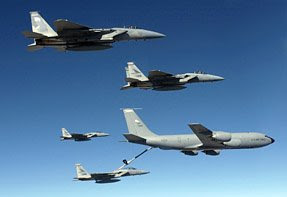APPLY FOR THIS OPPORTUNITY!
Or, know someone who would be a perfect fit? Let them know!
Share / Like / Tag a friend in a post or comment!
To complete application process efficiently and successfully, you must read the Application Instructions carefully before/during application process.
No jumping, please. The USAF plans to eliminate parachutes for tanker crews.
Air Force Times reports that the service has figured out a new way to save money–get rid of parachutes carried on KC-135 tankers.
According to a press release cited by the paper, “the likelihood a KC-135 crew member would ever need to use a parachute is extremely low.” The parachutes cost too much — in acquisition, maintenance and training — to make up for their relative uselessness on Stratotankers, according to the news release. Inspecting parachutes before flights is also extremely time-consuming, the Air Force claims.
Quite frankly, I think the idea makes a lot of sense. As one boom operator observed, if the aircraft is controllable, the crew isn’t going to bail out. If it’s out-of-control, the odds of reaching your chute, snapping it on and getting out the door are well…practically non-existent.
During my own days as a crew dog, I flew on a battle management platform. Our crew capsule was mounted in the cargo bay of a modified C-130. With a full battle staff, we had up to 15 people inside the capsule, which was also crammed with communications equipment, computer displays, seats and personal gear.
Saying it was a bit crowded in the back end of our aircraft would be an understatement. Still, our accommodations were almost spacious compared to other platforms. During a mission over Bosnia, we had an RAF warrant officer fly along with us. He was a linguist on a Nimrod SIGINT aircraft. As he described it, the crew compartment of his aircraft was crammed with kit, and an average of 25 linguists, EWOs and ELINT operators.
While the Air Force thoughtfully provided parachutes for our C-130s, bailing out would have required a Bolshoi-like ballet. Imagine coordinating the movements of 15 crew members; everyone had to stand up, grab the chute (from beneath their console), strap it on; line up, de-pressurize the aircraft, open the capsule and parachute doors, and then bail out.
By the time that happened, we figured, the plane would have crashed, or we could make an emergency landing. The same logic applies to a KC-135. Retire the chutes and save a little weight and money. If nothing else, the life support troops will be happy.
Besides, at one time it was considered poor form to jump out of a stricken aircraft. If it was good enough for Frank Luke and Eddie Rickenbacker, it ought to be good enough for today’s Air Force. Live in fame or go down in flames. Literally.
***
One thing we don’t understand about the Air Force press release is the reference to “harnesses that will secure them to the airplane” when they’re in danger of falling out. In our experience, the only time a tanker crew would face that risk is loading or off-loading cargo. And, as we noted in a recent post, the cargo-hauling mission of our tanker fleet is often over-stated.
How to Stop Missing Deadlines? Follow our Facebook Page and Twitter
!-Jobs, internships, scholarships, Conferences, Trainings are published every day!


